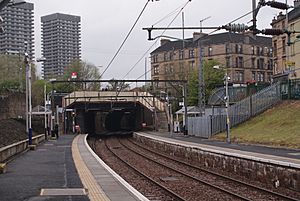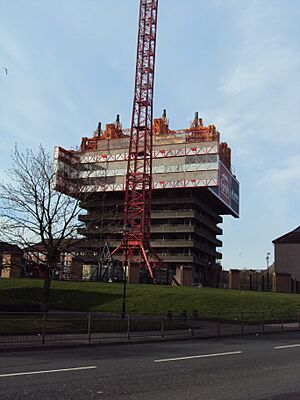Bluevale and Whitevale Towers facts for kids
Quick facts for kids 'Bluevale and Whitevale Towers' |
|
|---|---|
|
109 Bluevale Street/51 Whitevale Street
|
|
 |
|
| Alternative names | Bluevale/Whitevale Towers Gallowgate Twins Camlachie Twin Towers |
| General information | |
| Status | Demolished |
| Type | Residential |
| Architectural style | Brutalist |
| Address | 109 Bluevale Street 51 Whitevale Street |
| Town or city | Camlachie, Glasgow |
| Country | Scotland, United Kingdom |
| Construction started | 1967 |
| Completed | 1968 |
| Demolished | 2016 |
| Height | |
| Roof | 90.8 metres (298 ft) |
| Top floor | 30 (29 habitable + 2 mechanical) |
| Technical details | |
| Structural system | Pre-cast Concrete |
| Floor count | 30 |
| Lifts/elevators | 2 |
| Design and construction | |
| Architect | David Harvey Alex Scott & Associates |
The Bluevale and Whitevale Towers were two tall apartment buildings in Glasgow, Scotland. They were often called the Gallowgate Twins or Camlachie Twin Towers. These buildings were once the tallest structures in Scotland.
The towers had 29 floors where people lived. The 30th floor was for building equipment and drying clothes. Even though they were very tall, other buildings in Glasgow had higher occupied floors. The Red Road Flats were an example of this. In 2013, after the Inverkip Power Station was taken down, the Bluevale and Whitevale Towers became Scotland's second tallest freestanding structures for a short time. Both towers were taken down in 2016. Now, the Glasgow Tower is the tallest freestanding structure in Glasgow and Scotland.
History of Glasgow's Tall Buildings
After World War II, Glasgow needed many new homes. So, in the 1960s and early 1970s, the city built many tower blocks. This made Glasgow the first city in Britain with so many tall buildings.
It took a while for new tall buildings to be built again. In 1988, the 17-story Forum Hotel was built. Then, in 1992, the 20-story Hilton Hotel followed. Since the 1990s, Glasgow has been taking down some of its older residential tower blocks. This includes the Gorbals blocks, which were taken down in 1993.
The Bluevale and Whitevale Towers were special in how they were built. They had special hydraulic jacks in their foundations. These jacks helped stop the buildings from swaying because of their great height.
Why Were the Towers Taken Down?
In November 2011, the Glasgow Housing Association decided to take down the towers. They said that people didn't like living there much. Also, the buildings were very expensive to keep up and run.
The plan was to take them down before the 2014 Commonwealth Games. But the job was very difficult. So, the date was moved to early 2015. The buildings were very close to a busy railway line. Because of this, they could not be blown up with explosives.
Instead, they were taken apart floor by floor. This is called the "top-down" method. The work started in January 2015 with the Bluevale tower. The Whitevale tower was taken down in the same way in 2016.



